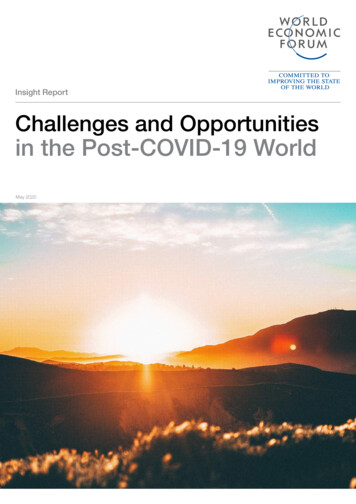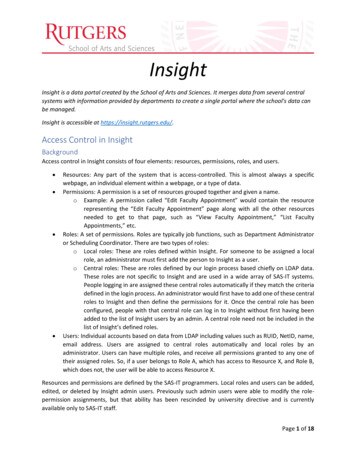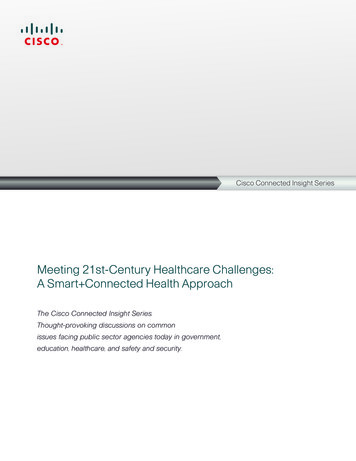
Transcription
Insight ReportChallenges and Opportunitiesin the Post-COVID-19 WorldMay 20201
World Economic Forum91-93 route de la CapiteCH-1223 Cologny/GenevaSwitzerlandTel.: 41 (0)22 869 1212Fax: 41 (0)22 786 2744E-mail: contact@weforum.orgwww.weforum.orgCopyright 2020 by the World Economic ForumAll rights reserved. No part of this publication may bereproduced, stored in a retrieval system, or transmitted,in any form or by any means, electronic, mechanical,photocopying, or otherwise without the prior permissionof the World Economic Forum.ISBN-13: 978-2-940631-02-5The Report is available at www.weforum.org.2Challenges and Opportunities in the Post-COVID-19 World
Challenges and Opportunitiesin the Post-COVID-19 WorldChallenges and Opportunities in the Post-COVID-19 World3
The views expressed in this e-bookrepresent those of the authors and not of theWorld Economic Forum.4Challenges and Opportunities in the Post-COVID-19 World
Contents062440IntroductionChapter 5Technology: DigitalEpiphany? COVID-19and Our Tech FuturesChapter 9Management:Catastrophic RiskTransfer in a PostPandemic World08Chapter 1Global Governance:Planning for the WorldAfter COVID-19Samir SaranNgaire WoodsChapter 6Economics: Trade andConnectivity in the PostCOVID-19 World44Pascal Lamy and Eduardo PedrosaChan Ghee Koh12Chapter 2Regional Governance:An Opportunity forRegional Organizations?Rolf Alter16Chapter 3Urban Governance:Cities in a Time ofCOVID-19Robert Muggah20Chapter 4Geopolitics: Resilient andSustainable GlobalizationCarolyn Kousky28Chapter 10A Socio-PsychologicalPerspectiveLeonard LeeCarolyn LoCatherine WongJanson Yap32Chapter 7Work: The Pandemicthat Stopped the World50AcknowledgementsSharan Burrow5236EndnotesChapter 8Health: ProvidingFree Health for All,EverywhereWinnie ByanyimaJulie Bishop and Anthea RobertsChallenges and Opportunities in the Post-COVID-19 World5
IntroductionWhile a global pandemic has been a looming risk fordecades, COVID-19 has come as a shock to society, healthsystems, economies and governments worldwide. In themidst of extraordinary challenges and uncertainty, andcountless personal tragedies, leaders are under pressureto make decisions on managing the immediate impact ofthe pandemic and its consequences, decisions that willshape the state of the world for years to come. What mightbe the silver linings in the crisis and how might leaders usethis moment to build a more prosperous, equitable andsustainable world?In this collection of essays, the Global Risks Advisory Boardof the World Economic Forum’s Global Risks Initiative looksbeyond the current crisis to the potential challenges andopportunities in the post-COVID-19 world. The result is arange of expert opinions from a geographically diverse setof leaders. They are designed to offer new perspectiveson the post-pandemic future, in support of efforts toproactively and collectively shape the future we want.The views represented are solely those of the authors anddo not represent the views of the World Economic Forum.6Challenges and Opportunities in the Post-COVID-19 World
REUTERS / HANNAH MCKAYChallenges and Opportunities in the Post-COVID-19 World7
CHAPTER 1Global Governance:Planning for the WorldAfter COVID-19Ngaire Woods,Blavatnik School ofGovernment, Universityof OxfordThe high-risk scenarioPolitics could turn toxic as governments failor struggle to speedily control the pandemic,to ease lockdowns safely, or to communicateclearly about what they are doing and why.Some politicians will resort to a discoursecombining fear and tribalism. This willexacerbate discrimination at home – as seenin some parts of the United States, China andAfter COVID-19 there is arisk that the world could beyet more divided, conflictualand nationalistic. But analternative scenario is withinreach. In this scenario,collective action withincommunities and, wherenecessary, internationally,will make a more rapid andpeaceful exit from the crisispossible.India – and jingoistic nationalism will also makeinternational cooperation more difficult.Failure to cooperate internationally will hinderthe fight against the virus. Closing down trade,requisitioning materials, or preventing supply toother nations will hobble everyone’s capacityto source adequate testing and treatmentmaterials. The closing of borders and rippingup of international rules will make it ever moredifficult to restart trade and travel, and extendthe lockdown, heightening anger and anxiety.The crisis has exposed how many people,even in some of the world’s richest countries,live in inadequate housing, without reserves ofcash or food, and face difficulties in accessinggovernment assistance. The global lockdownis exacting an enormous price from them. They8Challenges and Opportunities in the Post-COVID-19 World
will demand better, having seen the enormoustheir failure to cooperate after the First Worldsums governments have mobilized to deal withWar, how it drove the world into economicthe crisis.catastrophe (the Great Depression) and conflict(the Second World War) and resolved to doHowever, not all governments will be able tobetter. They started planning during the war.deliver.They knew that cooperation would be essentialto rebuild afterwards and to redevelop a globalGovernments will face gigantic debts. Manyeconomy within which each country could grow.households and businesses were alreadySo, too, global leaders must begin to plan post-heavily indebted before the crisis. Some will bepandemic cooperation.able to raise funding through the capital markets(the UK borrowed 45 billion in one month).Three tasks that confronted those leaders haveOthers will face ruinous rates for borrowingtheir parallel today. First and most immediate(South Africa has had its credit rating reducedis to fight the common enemy – now theto junk status). Investors will look for robustvirus – together. The second is political andinvestment plans, competent leadership andgeopolitical: Churchill, Roosevelt and Stalin hadrobust institutions. Most developing countriesto fashion a world that could accommodatewill be excluded. In short, a financial crisis is intheir own (and others’) diverse politicalthe offing and without international cooperation,regimes. The third task is economic. Economicbeggar-thy-neighbour policies are likely toreconstruction had to deal with massivedeepen economic recession for all.government debts and a broken global tradingand investment system.Finally, sabre-rattling and war offer a diversionfor politicians facing political and economicFighting the virus together requires cooperationturmoil at home. Building on their jingoisticon three things: research and knowledgenationalism, there is a risk that some will seek to(working together to understand and beat thefocus the anger and frustration of their citizensvirus); maintaining global supply (trade ensuringon another country. Already we are seeingefficient global supply of necessary materials);political leaders blame other countries for theirand warning of future outbreaks. This mightown failings, including for problems before thesound easy. It is very difficult. Why would acrisis.scientist share crucial data with others, or acountry continue to export protective equipmentOne scenario for the post-COVID-19 worldif they are not sure that other countries willhas political and economic forces fuelling fearreciprocate? Why warn of a disease outbreak ifand conflict, deepening economic damage,you think other countries will slam the door oneviscerating the possibility of growing out ofyou?the crisis and exacerbating divisions that thepandemic is already revealing.For cooperation to work, countries needto agree common rules and empower anA better scenarioThe world has managed extreme conditionsbefore. Leaders of the 1940s reflected oninstitution to oversee them. The World HealthOrganization (WHO) exists to do this, but it isoverstretched and underfunded. It needs to beChallenges and Opportunities in the Post-COVID-19 World9
properly funded to do its job. Its current budgetPoliticians in any system can be tempted tois about equal to that of one large US hospital,take popular rather than necessary decisions.and 83% of it is “voluntary” contributions,Consider democratic neighbours Sweden andwhich are tagged for special projects. It alsoDenmark: Sweden with far less of a lockdownneeds governments to hear and follow itsearly on has ended up with a much higheradvice. Since 4 January 2020, the WHOdeath rate. Similarly, Wuhan authorities playedhas shared information about the outbreak,down news of the virus and went ahead withproviding technical advice and guidance, andtheir Baibuting mass banquet on 9 February, toemphasizing the need to test, trace, and isolatedisastrous effect. Poor leadership results in badin order to contain the virus. Some majoroutcomes, whatever the political system.countries ignored the warnings and the advice.Perhaps alternative centres of power – atThere has, however, been cooperation amonglocal or city level – can offer insurance, andscientists from China, the US, Europe anda quicker way to get things done. Nationalamong businesses (e.g., the GSK team-upleaders in the US and Brazil were slow to takewith AstraZeneca). Some of that cooperationthe pandemic seriously but governors at thewas facilitated by the WHO, whose technicalstate level stepped up (albeit not resolvingguidance and advice have been taken up bythe need for coordination from the centre). Inmany countries. Although there have beenChina, the crisis exposed the overly politicizedexport controls, Germany has flown Italianaccountability of local government officials inpatients to its hospitals and China has sentWuhan. In Italy, mayors have stepped in toventilators and protective equipment to otherenforce what they describe as slightly confusingcountries. In Latin America, efforts are beingnational messages. The UK government wasmade to keep borders open while fighting theslow to mobilize an existing network of localvirus together. The key thing now is to tilt thisenvironmental health officers to trace contacts.mixture further in the direction of cooperation.All governments could do better by balancingThe WHO must be supported, financed andautonomy and agility at the local level withempowered to do everything possible to pointnational-level coordination.the world towards a virtuous circle of mutualtrust and away from a vicious cycle of dog-eat-It has become too easy for extremists to rattledog.sabres across social media. But jingoism andtalk of war will not resolve the core problemsImproving politicsDiverse political regimes must work together inthe world after COVID-19. People have beenquick to conclude victory either for autocracyor democracy in this crisis. Democracy hasbeen criticized for popularity-seeking instead ofpursuing technically sound policies. Autocracyhas been criticized for repression. But morehumble lessons need to be learned all round.10Challenges and Opportunities in the Post-COVID-19 Worldfacing the US or China, nor any other countryin the world. Government leaders facing anenormous challenge at home need to focustheir energies and efforts and agree to disagreewith some foreigners, yet also make a powerfulnew case to their citizens about cooperation.They must provide security at home and, as itsnecessary correlate, cooperation abroad.
ReconstructionEconomic reconstruction is the third challenge.After the Second World War, war-torn countrieswere desperate to get their economiesrestarted. Debts had to be written down. Newflows of investment had to be found. The resultwas a massive reset delivering mass housing,health, employment and education. This maynot be possible in 2020, but some changesoccurring during the crisis could be built upon.Increased solidarity is visible across societies,as they seek to attenuate the effects of thelockdown. In Nigeria, citizen-powered welfareorganizations and tech companies are steppingup to feed the poor. In the United Kingdom,high-end restaurants have stepped in to offermeals to hospital workers in the National HealthService. In China, volunteers made their wayto Wuhan to help at the height of the crisis.In France, those who have lost their jobs inthe cities are being encouraged to go to thecountryside to help farmers harvest produce.Across Europe people have made a regularfeature of singing and applauding the newlyrecognized “key workers” (nurses, carers,doctors, firefighters, rubbish collectors andsupermarket checkout operators), most ofwhom are low paid, and many immigrants.Communities are standing together, albeit at aphysical distance.To build on emerging solidarity will take verycareful and representative leadership. GlobalAt the international level, two lessons from thepost-war settlement stand out. The first is theneed for debt write-downs to enable countriesto grow out of the crisis. Packages and effortsto reduce the debt loads of developmentcountries announced by the InternationalMonetary Fund (IMF) and World Bank nowneed support from countries robust enough totap into bond markets and share the benefitsof their creditworthiness (through the creditpooling arrangements of multilaterals). Thesecond lesson is that major producers will needto invest in growth in their own future marketsin other countries. Post-war America did this.In today’s world, the US, China and Europe willhave to do the same.The post-COVID world will be shaped bydecisions being made in the crucible of thefight against the virus. The profound uncertaintyabout the virus and its trajectory, and abouthow other countries will respond, only magnifiesthe importance of leadership. At the very least,leaders across the world must cooperate tofight against the virus, collectively eliminatingit. They must do so without being distractedby political differences but by focusing on theextraordinary challenges that lie within theirown borders. They must make the case totheir citizens that security at home requirescooperation abroad. And finally, those that canwill need to invest in neighbours and in poorerparts of the world, for only together will theireconomies flourish.discussions float big ideas – “SustainableDevelopment Goals”, “stakeholder capitalism”,etc. – but the onus is on the proponents ofthese ideas to translate them into feasible stepsthat will help governments rebuild at a nationallevel after the crisis.Challenges and Opportunities in the Post-COVID-19 World11
CHAPTER 2Regional Governance: AnOpportunity for RegionalOrganizations?Rolf Alter,Hertie School ofGovernance. Berlin,Germany“Great Lockdown” (IMF), they forced 4 billioncitizens to stay at home. They have turnedinto paymasters of hundreds of thousands ofprivate companies and workers, affecting 2.7billion jobs, financed by accumulating publicdebt beyond imagination just a few monthsago. Central banks stand ready to inject nearlyunlimited liquidity. Now, their attention is turningto exiting the lockdowns and stimulatingeconomic recovery.What will change?It is difficult to imagine that the traumaticexperiences of the pandemic will be forgottenquickly or disappear entirely over time.The human losses alone will remain strongreminders of the implications of change at thelevel of society and individuals. The new startafter lockdown will certainly offer opportunitiesand carry risks for all. Our governance systems,in many ways our democracies, will continue tobe at the heart of this journey.headwinds long before the COVID pandemic,is there space for more regional cooperation incrisis management and recovery?Crisis management at regionallevel – the example of the EUWhile the European Union (EU) is certainlynot representative for regional organizationsin general, it can still offer an interestingperspective on the opportunities and risksNational governments as crisismanagersassociated with regional cooperation in theIn a seeming contradiction to the global reachArguably the EU is one of the regionalof the pandemic, governments at nationallevel, more accurately their leaders andexecutive branches, have taken the front seat inresponding to the COVID-19 crisis. Through the12With supranational collaboration facingChallenges and Opportunities in the Post-COVID-19 Worldcurrent situation.organizations of countries most preparedinstitutionally for close cooperation among itsmembers.1
Since the arrival of the pandemic, the EU hasinvestment effort (“recovery fund”) – the detailsbeen actively responding to the challenges, withof which are expected to be settled in thornyuneven results so far. Activating the mechanismnegotiations – and integration into a globalfor an Integrated Political Crisis Responseresponse. Overall, the financial package of the(IPCR) on 2 March 2020, it decided – amongEU could reach 2 trillion – a multiple of the USother measures – on practical assistancegovernment crisis commitments.between member countries, amended the EUbudget in support of healthcare systems, andRecognizing the weakness of currentpooled research funds to develop treatmentsgovernance arrangements in the EU,and vaccines. The previous deficit and debtaccentuated by the COVID-19 crisis, thelimits of national budgets (3% and 60%,Roadmap suggests reexamining the rulesrespectively) were lifted to accommodateand functioning of the Union against theexceptional spending. Safety nets to minimizeexperience of its crisis management so far. Itthe fallout of the crisis on jobs and workers,calls for improving its executive capacity andbusinesses and member states in the EU werecrisis management. Respect for the rule of lawset up. The European Central Bank announcedand human dignity should ensure a strong,a 750 billion pandemic emergency purchaserobust and inclusive recovery. The roadmapprogramme to ensure access to liquidity.also demands buy-in from governments andIn total, the EU and its member states areparliaments, from social partners and citizens.mobilizing 3% of EU GDP in fiscal measuresand 16% in liquidity support.2More coordination is in the making. On 23April 2020, the European Council welcomed acomprehensive recovery plan developed by theWhat are the potential risks ofregional cooperation from agovernance perspective?Lack of trustEU Commission. It is frequently referred to as aThe central question is whether the institutionsnew Marshall Plan, although its format, size andof regional organizations can earn the trust ofstructure are going to be far from the historicalthe citizens of its member countries. In the EU,original first proposed in 1947.the concerns of the relationship with citizenscan structurally be traced back to a range ofAccording to the draft Roadmap for Recovery3,factors – a technocratic and un-transparentaction could go far beyond the direct responseEU bureaucracy, a still weak democraticto the crisis. Its ultimate objective of buildingrepresentation of citizens through the Europeana more resilient, sustainable and fair EuropeParliament and the perceived impact on themakes it a much more forward-lookinglife of citizens. Despite the EU’s significantambitious reform agenda for years to come.influence on and budget support for agriculture,Its basic principles are solidarity, cohesion andtransport, communication or regionalconvergence. Key areas for action are a fullydevelopment in the European space, citizensfunctioning and revitalized single market, thestill attribute public policies and the deliverygreen transition and the digital transformation ofof public goods and services generally toEurope. It proposes to ensure greater strategicnational governments rather than the Europeanautonomy of the EU, an unprecedentedinstitutions. In the interest of effective crisis andChallenges and Opportunities in the Post-COVID-19 World13
recovery management, regional organizationsDivisions are potentially widening, as headsshould pay prime attention to their interactionof government of all political colours haveand communications with citizens.tended to call on national unity in their crisismanagement. Democratic process, the roleLack of solidarityAs EU member countries have differenttrajectories, vulnerabilities and capacities inthe crisis – France, Italy and Spain encounterhigher rates of COVID-19 victims than someof the Nordic members – their calls forof parliaments and accountability are beingreduced, in some member countries to the bareformal minimum.Complexity of managing systemic risk of thepandemicsupport are awaiting convincing responses.The pandemic is a perfect case of systemicWhile assistance at practical levels has beenrisk. Will the EU be able to adopt an effectiveforthcoming, the financial package of credit linesrisk-governance approach, where institutionalfor member states took extended discussionsroles and capacities need to keep up withbefore an agreement was reached. The financialthe economic, social and environmentaldimensions in terms of size and structure of thecomplexities? Where a network perspectiverecovery fund have already led to major tensionsis critical and individual and institutionalbetween heads of state. Failing on solidaritydecision-makers need greater accountabilityamong member countries is missing one of theand responsibility? Initiating or renewingraisons d’être of regional cooperation. It couldmultistakeholder dialogue as envisaged in thehave serious consequences for cohesion andRoadmap would further enhance effective riskmembership.governance.Rising nationalismWhat are the opportunities ofmore regional cooperation in thecurrent situation?In recent years, populist national identity politicshave come to the fore among EU membercountries questioning greater integration andIncreased learning of experiences andclaiming more national autonomy. The EU spractices2015-2016 migration crisis reinforced that trendconsiderably. Brexit is the most prominentcase of the choice of independence overcommitment to the EU.During the crisis, governments implemented theclosure of internal borders despite the principleof freedom of movement as a key building blockof the EU. The guidelines of the EU for exitingthe national containment measures are beinginterpreted quite independently among membercountries. The case of separate strategies forthe health sector is different since it is undernational competence.Regional cooperation offers critical opportunitiesof learning from others and to achievecollectively what would not be possible at theindividual country level. As the COVID crisis isunique, there are opportunities for a quantumleap in systemic crisis management to bebetter prepared next time around. Moreover,governments will benefit from exchanges withregional partners as they confront new andmore challenges during reconstruction.The division of societyA fair Europe, as the draft Roadmap stipulates,would be an opportunity to tackle the14Challenges and Opportunities in the Post-COVID-19 World
many dimensions of persistent inequalitiesreducing inequality and contributing to aof societies, within member countries andsustainable world are promising incentives forbetween them. A shared vision may also help toregional organizations.avoid new dividing lines within societies beingintroduced through shielding and isolating riskThe stakes are high beyond crisis management.groups, among them the poor, minorities andIn an increasingly bipolar world, regionalthe old.cooperation may be the only vehicle for manycountries to have a voice in shaping the globalIntegrating recovery, the Green Deal andrules of the game. If the EU serves as anydigital transformationindication, regional cooperation can be messyIntegrating the three critical policy challengesinto the development of the Roadmap wouldat times. But it definitely looks like it is worth theeffort.raise the opportunities for a sustainable policyconcept at the level of the EU. It would alsoenable the EU to have a voice as a strategicpartner in shaping the one world there is andwhich the pandemic has made so obvious.There is likely to be strong bottom-up supportfrom citizens. The French citizen convention forclimate – a celebrated innovation of PresidentMacron of citizen participation in public policies– has proposed to make the design of the postCOVID-19 world an instrument of sustainableclimate change.Regional cooperation makessenseRegional cooperation in overcoming thecrisis and building the post-COVID worldmakes sense. Paying attention to governancearrangements will play an important role inlimiting human losses and keeping societies andeconomies together.Much depends on the underlying shared valuesof regional organizations, their institutionalstructures and capabilities, and the buy-in ofits member countries and citizens. Amongthe risk factors, lack of trust, lack of solidarityand growing nationalism stand out. Theopportunities of engaging in collective learning,Challenges and Opportunities in the Post-COVID-19 World15
CHAPTER 3Urban Governance:Cities in a Time ofCOVID-19Robert Muggah,SecDev Group, Ottawaand Igarape Instiute,Rio de JaneiroTo date, many of the most able and agileresponses to COVID-19 have come not fromnational governments but from municipal ones.Cities are key to preparednessand responseShortly after the coronavirus overwhelmedWuhan in early 2020, the pandemic’s centre ofThe COVID-19 pandemicis exposing the qualityof governance andcompetence of the world’sleaders. In times of crisis,most people instinctivelyturn to their governmentsfor protection andassistance. When politiciansand civil servants fail todeliver, they quickly losecredibility and legitimacy.Emergencies reveal thehealth of the social contract.And in crisis, competencematters.gravity shifted westward from Seoul to Milan,Madrid and New York. It was more successfullycontained in faster-responding cities like Berlin,Copenhagen, Hong Kong and Taipei. Aroundthe world, cities are just spreaders of infectionbut also key to containing it. The eventual“restart” of most economies depends on thecondition of the biggest cities because theyare engines of growth and productivity. In theUS, the 50 most badly affected counties areresponsible for roughly one third of the country’semployment and economic output. Ensuringthat COVID-19 is under control in large urbanhubs is crucial before “opening up” a country forbusiness. Cities will lead recovery and redesignin its aftermath.All cities are vulnerable to COVID-19, butsome are more at-risk than others. Somefactors stand out: a city’s size, density andlevel of pollution influence the trajectory of viraloutbreaks. Megacities like London, Mumbai,16Challenges and Opportunities in the Post-COVID-19 World
New York and São Paulo, with highly populatedCitizens in China are being assigned QRresidential areas and constant inflows ofcodes on their mobile phones to track theirvisitors and migrants, are disproportionatelymovements and people designated “green” areaffected. Cities and regions relying on globalpermitted to leave their homes for a few hours asupply chains, such as Hubei or Lombardy, areday. Restrictions on some categories of workersalso vulnerable. Meanwhile, cities dependingare being eased, but physical interaction ison tourism, with a high proportion of elderlydiscouraged. In some parts of the country,populations and minorities, or suffering fromvillager migration to cities is being restricted bydeep social and economic disparities, are alsoresidential-management committees.more prone to higher infections, hospitalizationsand fatalities. Neighbourhood inequalities alsoMany European cities are also graduallymatter. In wealthier areas, some residents canemerging from lockdown and easing socialshelter in place, access high-quality care anddistancing and quarantine measures. Largerwork remotely, while in poorer ones, multipleand smaller cities in Denmark, Germany,families are clustered tightly together makingNorway, Spain and Switzerland are cautiouslysocial distancing impossible.opening day-cares, schools and universitiesalongside businesses. Local authoritiesReopening the cityCOVID-19 will likely persist for years. Even withthe most sophisticated testing and contacttracing, cities will suffer waves of infectiousoutbreaks until immunity takes hold or antiviraltherapies and vaccines are developed. Andyet cities cannot, and will not, stay lockeddown indefinitely. If they do, spiralling foodprices, rising unemployment, economicdisintegration and social and political unrestwill follow. Despite tremendous uncertainties,local governments around the world are alreadyplanning for when and how to reopen. Wuhanwas one of the first to do so, shifting from“suspension” to “full restart” after only 75 daysin strict lockdown.Many cities will not return to anythingapproximating business-as-usual in the comingyears. In the hardest-hit cities, extensiveprecautions and restrictions will remain in placeindefinitely. These will vary in intensity andinvasiveness. In China, Singapore and SouthKorea, face masks, test kits and technologyenabled controls are already ubiquitous.recognize that they will need to reimposecurfews and shelter-in-place measures ifinfections rise again. In the US, the process ismore chaotic. There are bitter disagreementsamong federal, state and municipal authoritiesabout whether, when and how to reopen. Thescientific consensus there, however, is that earlycalls to “get back to business” are dangerouslypremature.The situation is more uncertain in African,South Asian and Latin American cities thathave much less robust health systems and willrely on proactive prevention and containmentmeasures to keep the virus under control. Butthe economic reserves of many lower-incomecities are already overstretched and somewill take longer to recover than their wealthiercounterparts. Cities from Lagos to Mumbaito Rio de Janeiro have locked down, but forresidents of crowded slums the unenviablechoice is often between a risk of catching andspreading disease or the certainty
6 Challenges and Opportunities in the Post-COVID-19 World Introduction While a global pandemic has been a looming risk for decades, COVID-19 has come as a shock to society, health










